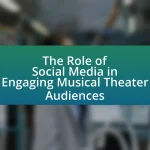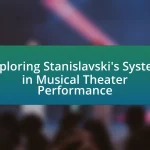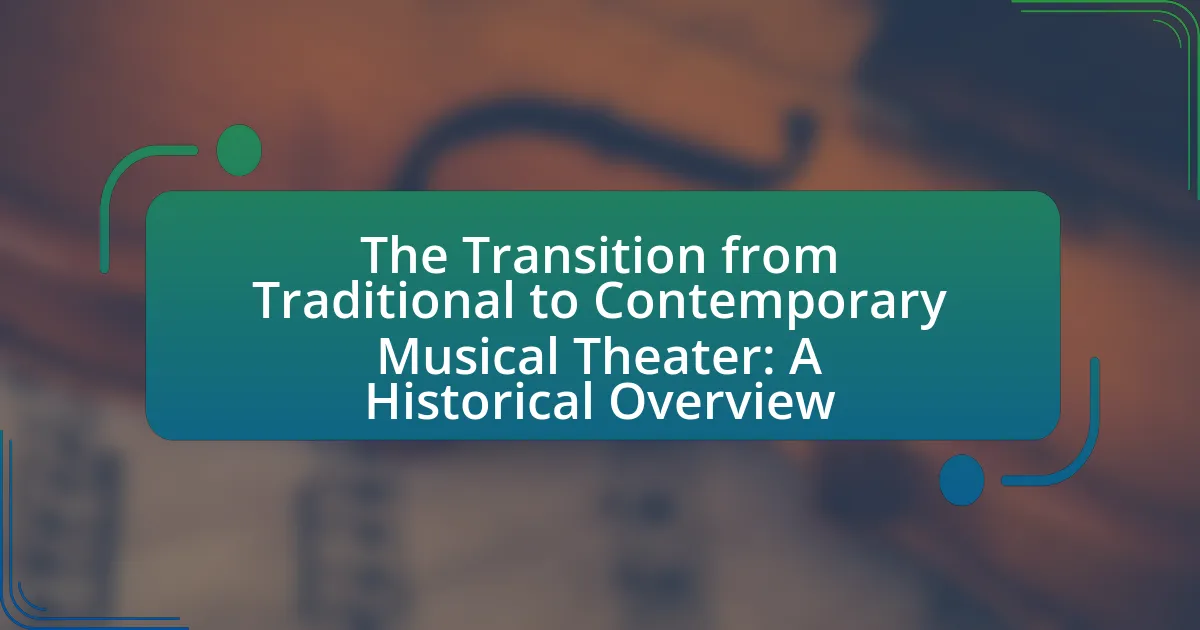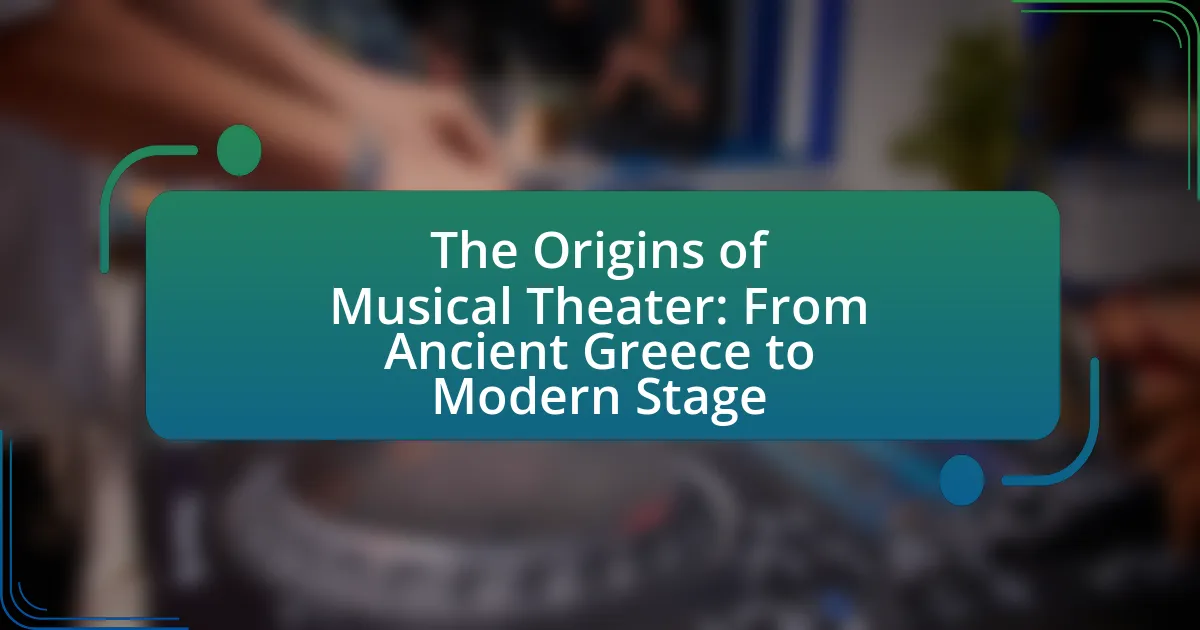The Harlem Renaissance was a pivotal cultural movement in the 1920s that significantly influenced musical theater by introducing African American themes, styles, and artists into mainstream performance. This era fostered a new sense of identity and pride among African Americans, leading to the creation of works that celebrated their culture and experiences, exemplified by productions like “Porgy and Bess” and “Shuffle Along.” Key figures such as Duke Ellington and Langston Hughes played crucial roles in shaping this artistic landscape, which emphasized themes of racial identity, social justice, and cultural pride. The innovations in musical styles and performance techniques during this period laid the groundwork for future generations of artists, making the Harlem Renaissance a foundational moment in American musical theater history.
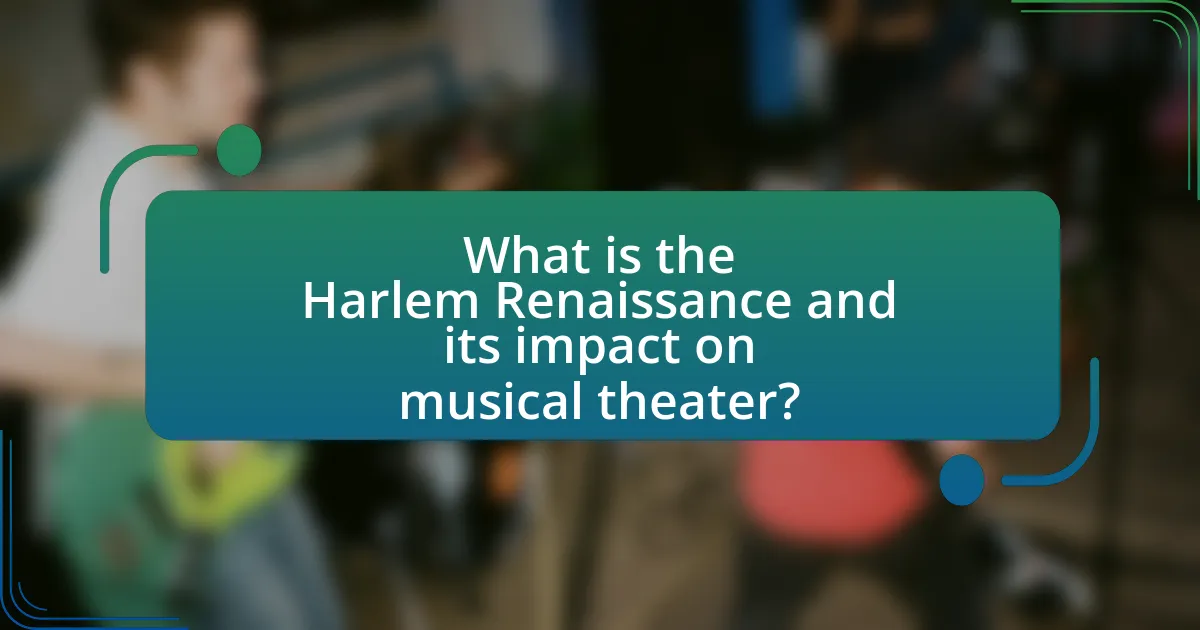
What is the Harlem Renaissance and its impact on musical theater?
The Harlem Renaissance was a cultural, social, and artistic explosion centered in Harlem, New York, during the 1920s, significantly influencing musical theater. This movement fostered a new sense of identity and pride among African Americans, leading to the creation of works that celebrated Black culture, history, and experiences. Notable figures such as Duke Ellington and Langston Hughes emerged, contributing to a rich tapestry of artistic expression that included jazz, blues, and theatrical performances. The impact on musical theater is evident in productions that incorporated African American themes, styles, and talent, paving the way for future generations and shaping the landscape of American theater. For instance, the musical “Porgy and Bess,” composed by George Gershwin in 1935, exemplifies this influence by integrating jazz elements and portraying the lives of African Americans in the South.
How did the Harlem Renaissance influence the development of musical theater?
The Harlem Renaissance significantly influenced the development of musical theater by introducing African American cultural themes, styles, and artists into mainstream performance. This cultural movement, which flourished in the 1920s, showcased the talents of Black musicians, writers, and performers, leading to the creation of works that celebrated African American identity and experiences. Notable productions like “Porgy and Bess” by George Gershwin and “Shuffle Along” by Noble Sissle and Eubie Blake incorporated jazz, blues, and spirituals, reflecting the musical innovations of the era. The Harlem Renaissance also fostered a greater appreciation for Black artistry, paving the way for future generations of African American performers and composers in musical theater.
What key themes emerged in musical theater during the Harlem Renaissance?
Key themes that emerged in musical theater during the Harlem Renaissance include racial identity, social justice, and cultural pride. These themes were prominently featured in works such as “Porgy and Bess” by George Gershwin and “Shuffle Along” by Noble Sissle and Eubie Blake, which highlighted the African American experience and addressed issues of discrimination and inequality. The Harlem Renaissance fostered a sense of community and celebration of African American culture, as seen in the incorporation of jazz and blues music into theatrical performances, reflecting the era’s artistic innovation and the quest for civil rights.
How did the cultural context of the Harlem Renaissance shape musical theater narratives?
The cultural context of the Harlem Renaissance significantly shaped musical theater narratives by emphasizing themes of racial identity, social justice, and cultural pride. This period, spanning the 1920s, fostered a vibrant artistic expression among African Americans, leading to the incorporation of jazz, blues, and spirituals into theatrical works. Notable productions like “Porgy and Bess” and “Shuffle Along” reflected the complexities of African American life, showcasing both struggles and triumphs. The Harlem Renaissance also encouraged collaboration among artists, resulting in innovative storytelling that challenged prevailing racial stereotypes and highlighted the richness of Black culture. This cultural movement laid the groundwork for future musical theater, influencing narratives that continue to resonate today.
What role did prominent figures play in the Harlem Renaissance’s musical theater?
Prominent figures played a crucial role in shaping the musical theater of the Harlem Renaissance by introducing innovative artistic expressions and elevating African American culture. Notable individuals such as Duke Ellington and Billie Holiday contributed significantly to the genre, blending jazz and blues with theatrical performances, which helped to redefine American musical theater. Their works, including Ellington’s compositions for stage productions and Holiday’s emotive singing style, showcased the richness of African American experiences and influenced future generations of artists. This cultural movement not only provided a platform for African American talent but also challenged racial stereotypes, making a lasting impact on the landscape of American theater.
Who were the major composers and lyricists of the Harlem Renaissance?
The major composers and lyricists of the Harlem Renaissance included Duke Ellington, Billie Holiday, and Langston Hughes. Duke Ellington was a pivotal figure in jazz music, known for his innovative compositions and orchestration that shaped the genre. Billie Holiday, a renowned jazz and blues singer, collaborated with various composers to create iconic songs that reflected the African American experience. Langston Hughes, primarily recognized as a poet, also contributed significantly to musical theater through his lyrics, particularly in works like “Porgy and Bess.” These artists played crucial roles in defining the musical landscape of the Harlem Renaissance, influencing future generations and highlighting the cultural significance of African American artistry during this period.
What contributions did performers make to the musical theater scene during this period?
Performers during the Harlem Renaissance significantly enriched the musical theater scene by introducing innovative styles, themes, and cultural expressions. They brought African American experiences and narratives to the forefront, exemplified by productions like “Porgy and Bess,” which showcased the complexities of Black life in America. Additionally, performers such as Paul Robeson and Ethel Waters broke racial barriers, gaining prominence in mainstream theater and influencing future generations. Their contributions not only elevated the artistic quality of musical theater but also fostered greater acceptance and appreciation of African American culture within the broader American artistic landscape.
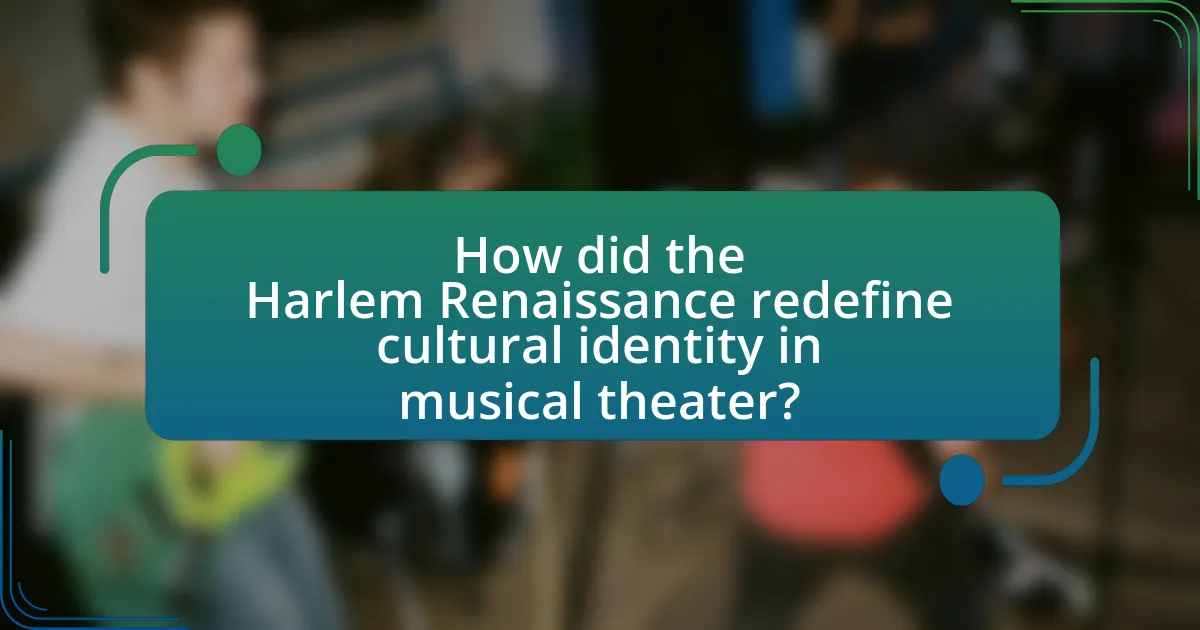
How did the Harlem Renaissance redefine cultural identity in musical theater?
The Harlem Renaissance redefined cultural identity in musical theater by emphasizing African American experiences, artistry, and narratives. This cultural movement, which flourished in the 1920s, introduced a new wave of creativity that showcased Black talent and addressed social issues through performance. Notable works, such as “Porgy and Bess” by George Gershwin and “Shuffle Along,” highlighted the richness of Black culture and challenged prevailing stereotypes. The integration of jazz, blues, and spirituals into musical theater not only transformed the genre but also fostered a sense of pride and identity among African Americans, making their stories central to American culture. This shift was significant as it laid the groundwork for future generations of artists and redefined the landscape of American musical theater.
What new artistic expressions emerged from the Harlem Renaissance in musical theater?
The Harlem Renaissance introduced innovative artistic expressions in musical theater, notably through the integration of jazz, blues, and African American cultural themes. This period saw the emergence of works like “Porgy and Bess” by George Gershwin, which blended classical music with jazz elements, showcasing the richness of African American life. Additionally, the use of vernacular language and storytelling techniques in productions like “Shuffle Along” highlighted the experiences and struggles of Black Americans, creating a new narrative style that resonated with audiences. These artistic expressions not only transformed musical theater but also laid the groundwork for future generations of artists, emphasizing the importance of cultural identity and heritage in performance.
How did musical styles evolve during the Harlem Renaissance?
Musical styles evolved during the Harlem Renaissance through the fusion of African American musical traditions with jazz, blues, and gospel influences. This period, spanning the 1920s, saw the emergence of jazz as a dominant genre, characterized by improvisation and syncopation, which reflected the cultural and social dynamics of the time. Notably, artists like Duke Ellington and Louis Armstrong played pivotal roles in popularizing jazz, while the blues, exemplified by figures such as Bessie Smith, expressed the struggles and emotions of African Americans. The integration of these styles into theatrical performances also marked a significant shift, as musicals began to incorporate jazz rhythms and blues melodies, leading to a new form of entertainment that resonated with broader audiences. This evolution not only transformed the musical landscape but also highlighted the cultural significance of African American experiences during the Harlem Renaissance.
What innovations in performance and staging were introduced during this era?
During the Harlem Renaissance, significant innovations in performance and staging emerged, notably the integration of jazz music and dance into theatrical productions. This era saw the introduction of more dynamic choreography and the use of elaborate set designs that reflected African American culture and aesthetics. Productions like “Shuffle Along” (1921) showcased syncopated rhythms and improvisational styles, which transformed the conventional musical theater format. Additionally, the use of lighting techniques and innovative stagecraft enhanced the visual storytelling, allowing for more expressive performances that resonated with audiences. These advancements not only elevated the artistic quality of performances but also contributed to the broader acceptance and appreciation of African American artistry in mainstream theater.
Why is the Harlem Renaissance significant in the context of American musical theater history?
The Harlem Renaissance is significant in American musical theater history because it marked a pivotal cultural movement that elevated African American artistic expression and reshaped the landscape of theater. This era, spanning the 1920s, saw the emergence of influential figures such as Duke Ellington and Billie Holiday, who infused jazz and blues into theatrical performances, thereby broadening the musical palette of American theater. The production “Porgy and Bess,” composed by George Gershwin in 1935, exemplifies this influence, as it incorporated African American musical styles and themes, reflecting the cultural richness of the Harlem Renaissance. This movement not only provided a platform for black artists but also challenged racial stereotypes, leading to a more inclusive representation in the arts.
What lasting effects did the Harlem Renaissance have on future generations of musical theater artists?
The Harlem Renaissance significantly influenced future generations of musical theater artists by fostering a rich cultural legacy that emphasized African American identity and artistic expression. This period introduced themes of racial pride, social justice, and cultural heritage into musical theater, which became foundational elements in works such as “Porgy and Bess” and “Cabaret.” The integration of jazz, blues, and gospel music into theatrical productions can be traced back to the innovations of artists during the Harlem Renaissance, such as Duke Ellington and Billie Holiday. Their contributions not only shaped the sound of American music but also paved the way for subsequent artists to explore complex narratives around race and identity in their works. The impact of the Harlem Renaissance is evident in the continued celebration of African American culture in contemporary musical theater, as seen in productions like “Hamilton” and “The Color Purple,” which draw directly from the artistic advancements and cultural dialogues initiated during this transformative era.
How is the legacy of the Harlem Renaissance reflected in contemporary musical theater?
The legacy of the Harlem Renaissance is reflected in contemporary musical theater through the incorporation of African American cultural themes, storytelling, and musical styles. Productions like “Hamilton” and “The Color Purple” showcase narratives centered on the African American experience, echoing the themes of identity and resilience that were prominent during the Harlem Renaissance. Additionally, the use of jazz, blues, and gospel music in these works pays homage to the musical innovations of that era, highlighting the influence of artists such as Duke Ellington and Billie Holiday. This connection not only celebrates the historical contributions of African Americans to the arts but also continues to challenge societal norms and promote cultural dialogue, mirroring the transformative spirit of the Harlem Renaissance.
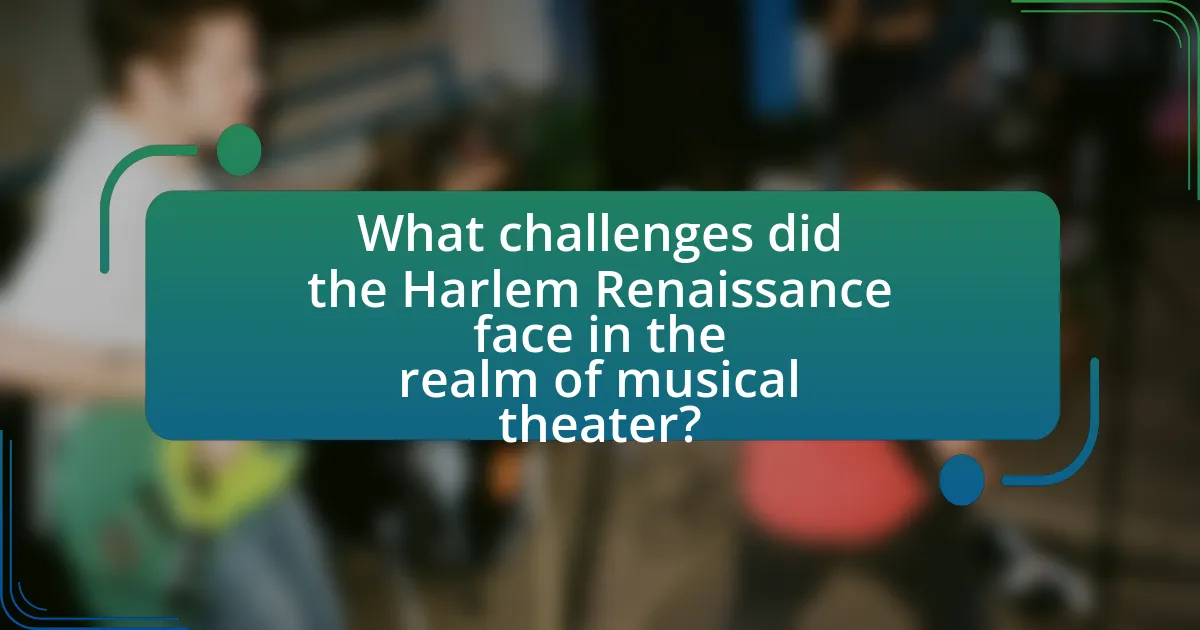
What challenges did the Harlem Renaissance face in the realm of musical theater?
The Harlem Renaissance faced significant challenges in the realm of musical theater, primarily due to racial discrimination and limited access to mainstream venues. African American artists struggled to gain recognition and financial support, as the entertainment industry was dominated by white producers and audiences. For instance, many theaters refused to showcase Black talent, forcing artists to perform in segregated venues or face censorship. Additionally, the prevailing stereotypes and societal attitudes of the time often marginalized the contributions of Black musicians and playwrights, hindering their ability to fully express their artistic vision. This systemic inequality created barriers that stifled the growth and visibility of African American musical theater during the Harlem Renaissance.
How did societal attitudes impact the reception of Harlem Renaissance musical theater?
Societal attitudes significantly influenced the reception of Harlem Renaissance musical theater by shaping both audience expectations and critical responses. During the Harlem Renaissance, prevailing racial stereotypes and segregationist attitudes often led to a mixed reception; while some white audiences embraced the innovative art forms, others dismissed them as inferior or merely entertainment for Black audiences. For instance, productions like “Shuffle Along” in 1921 gained popularity and broke box office records, indicating a shift in acceptance, yet they still faced criticism rooted in racial prejudice. This duality in reception reflected broader societal tensions regarding race, culture, and identity, ultimately impacting the longevity and legacy of these theatrical works.
What barriers did artists encounter in gaining recognition and support?
Artists during the Harlem Renaissance faced significant barriers in gaining recognition and support, primarily due to systemic racism and limited access to mainstream platforms. The prevailing racial discrimination restricted opportunities for Black artists in theater, leading to underrepresentation in major productions and limited financial backing. For instance, many Black performers were relegated to stereotypical roles or excluded from Broadway entirely, which stifled their artistic expression and visibility. Additionally, the economic challenges of the era made it difficult for Black artists to secure funding or sponsorship, further hindering their ability to reach wider audiences. These factors collectively contributed to a challenging environment for artists seeking acknowledgment and support in the musical theater landscape of the time.
How did racial discrimination affect the production and performance of musical theater during this time?
Racial discrimination significantly hindered the production and performance of musical theater during the Harlem Renaissance by limiting opportunities for Black artists and restricting the themes and narratives that could be explored. The prevailing segregationist attitudes led to the exclusion of Black performers from mainstream productions, resulting in a reliance on stereotypes and a lack of authentic representation in the narratives presented on stage. For instance, the 1921 musical “Shuffle Along,” which was one of the first to feature an all-Black cast, faced challenges in securing venues and audiences due to racial biases, yet it became a landmark production that showcased Black talent and creativity. This discrimination not only stifled artistic expression but also perpetuated a cycle of marginalization, as the dominant culture often dismissed the contributions of Black artists, thereby limiting the diversity and richness of the musical theater landscape during this era.
What lessons can be learned from the Harlem Renaissance’s influence on musical theater?
The Harlem Renaissance’s influence on musical theater teaches the importance of cultural representation and the power of artistic expression in challenging societal norms. This period, spanning the 1920s, showcased African American artists who infused their cultural heritage into theater, leading to the emergence of works that highlighted racial identity and social issues. Notable productions like “Porgy and Bess,” created by George Gershwin, exemplified this integration of African American culture into mainstream musical theater, demonstrating that diverse narratives can resonate widely. The success of these works underscores the lesson that inclusive storytelling enriches the arts and fosters greater understanding among audiences.
How can contemporary artists draw inspiration from the Harlem Renaissance?
Contemporary artists can draw inspiration from the Harlem Renaissance by exploring its themes of racial identity, cultural pride, and social justice. The Harlem Renaissance, which flourished in the 1920s, celebrated African American culture through literature, music, and visual arts, providing a rich source of material for modern creators. Artists can reference the works of key figures such as Langston Hughes and Zora Neale Hurston, who addressed the complexities of African American life, or incorporate the musical styles of jazz and blues that emerged during this period. This historical context not only informs contemporary narratives but also encourages a dialogue about ongoing issues of race and identity in today’s society.
What best practices can be adopted from the Harlem Renaissance for modern musical theater productions?
Best practices that can be adopted from the Harlem Renaissance for modern musical theater productions include the incorporation of diverse cultural narratives, the celebration of African American identity, and the use of innovative musical styles. The Harlem Renaissance was characterized by a flourishing of African American arts, where artists like Duke Ellington and Langston Hughes emphasized the importance of cultural expression and storytelling. By integrating these elements, modern productions can create more authentic and relatable narratives that resonate with a broader audience. Additionally, the use of jazz and blues, which were pivotal during the Harlem Renaissance, can enhance the musicality and emotional depth of contemporary works, reflecting the rich heritage of African American music.

